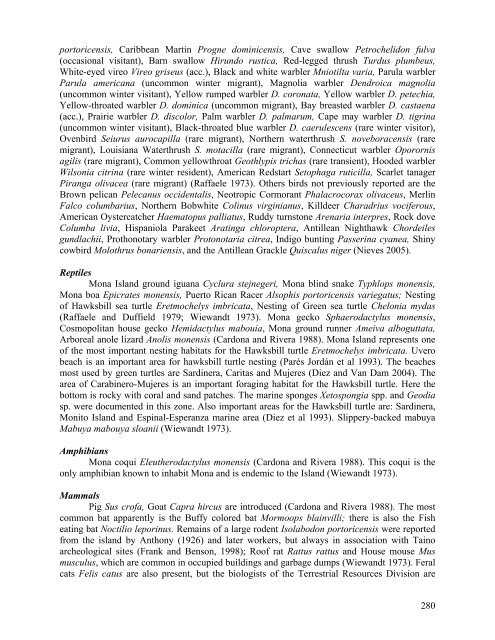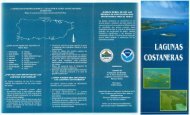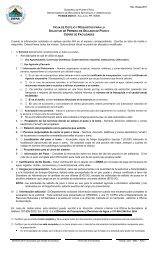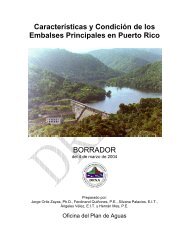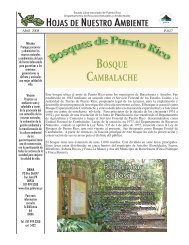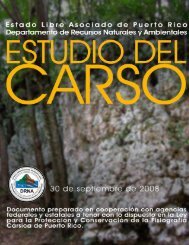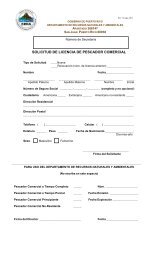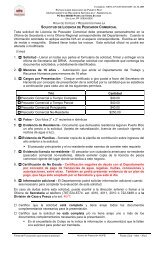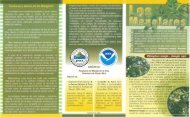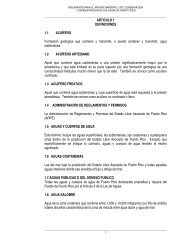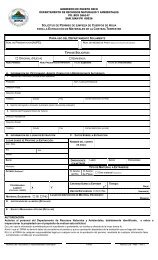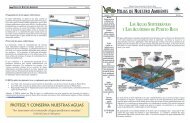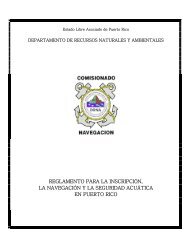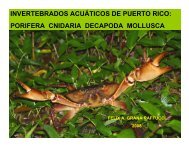Puerto Rico Critical Wildlife Areas - Puerto DRNA - Gobierno de ...
Puerto Rico Critical Wildlife Areas - Puerto DRNA - Gobierno de ...
Puerto Rico Critical Wildlife Areas - Puerto DRNA - Gobierno de ...
Create successful ePaper yourself
Turn your PDF publications into a flip-book with our unique Google optimized e-Paper software.
portoricensis, Caribbean Martin Progne dominicensis, Cave swallow Petrochelidon fulva<br />
(occasional visitant), Barn swallow Hirundo rustica, Red-legged thrush Turdus plumbeus,<br />
White-eyed vireo Vireo griseus (acc.), Black and white warbler Mniotilta varia, Parula warbler<br />
Parula americana (uncommon winter migrant), Magnolia warbler Dendroica magnolia<br />
(uncommon winter visitant), Yellow rumped warbler D. coronata, Yellow warbler D. petechia,<br />
Yellow-throated warbler D. dominica (uncommon migrant), Bay breasted warbler D. castaena<br />
(acc.), Prairie warbler D. discolor, Palm warbler D. palmarum, Cape may warbler D. tigrina<br />
(uncommon winter visitant), Black-throated blue warbler D. caerulescens (rare winter visitor),<br />
Ovenbird Seiurus aurocapilla (rare migrant), Northern waterthrush S. noveboracensis (rare<br />
migrant), Louisiana Waterthrush S. motacilla (rare migrant), Connecticut warbler Oporornis<br />
agilis (rare migrant), Common yellowthroat Geothlypis trichas (rare transient), Hoo<strong>de</strong>d warbler<br />
Wilsonia citrina (rare winter resi<strong>de</strong>nt), American Redstart Setophaga ruticilla, Scarlet tanager<br />
Piranga olivacea (rare migrant) (Raffaele 1973). Others birds not previously reported are the<br />
Brown pelican Pelecanus occi<strong>de</strong>ntalis, Neotropic Cormorant Phalacrocorax olivaceus, Merlin<br />
Falco columbarius, Northern Bobwhite Colinus virginianus, Kill<strong>de</strong>er Charadrius vociferous,<br />
American Oystercatcher Haematopus palliatus, Ruddy turnstone Arenaria interpres, Rock dove<br />
Columba livia, Hispaniola Parakeet Aratinga chloroptera, Antillean Nighthawk Chor<strong>de</strong>iles<br />
gundlachii, Prothonotary warbler Protonotaria citrea, Indigo bunting Passerina cyanea, Shiny<br />
cowbird Molothrus bonariensis, and the Antillean Grackle Quiscalus niger (Nieves 2005).<br />
Reptiles<br />
Mona Island ground iguana Cyclura stejnegeri, Mona blind snake Typhlops monensis,<br />
Mona boa Epicrates monensis, <strong>Puerto</strong> Rican Racer Alsophis portoricensis variegatus; Nesting<br />
of Hawksbill sea turtle Eretmochelys imbricata, Nesting of Green sea turtle Chelonia mydas<br />
(Raffaele and Duffield 1979; Wiewandt 1973). Mona gecko Sphaerodactylus monensis,<br />
Cosmopolitan house gecko Hemidactylus mabouia, Mona ground runner Ameiva alboguttata,<br />
Arboreal anole lizard Anolis monensis (Cardona and Rivera 1988). Mona Island represents one<br />
of the most important nesting habitats for the Hawksbill turtle Eretmochelys imbricata. Uvero<br />
beach is an important area for hawksbill turtle nesting (Parés Jordán et al 1993). The beaches<br />
most used by green turtles are Sardinera, Caritas and Mujeres (Diez and Van Dam 2004). The<br />
area of Carabinero-Mujeres is an important foraging habitat for the Hawksbill turtle. Here the<br />
bottom is rocky with coral and sand patches. The marine sponges Xetospongia spp. and Geodia<br />
sp. were documented in this zone. Also important areas for the Hawksbill turtle are: Sardinera,<br />
Monito Island and Espinal-Esperanza marine area (Diez et al 1993). Slippery-backed mabuya<br />
Mabuya mabouya sloanii (Wiewandt 1973).<br />
Amphibians<br />
Mona coqui Eleutherodactylus monensis (Cardona and Rivera 1988). This coqui is the<br />
only amphibian known to inhabit Mona and is en<strong>de</strong>mic to the Island (Wiewandt 1973).<br />
Mammals<br />
Pig Sus crofa, Goat Capra hircus are introduced (Cardona and Rivera 1988). The most<br />
common bat apparently is the Buffy colored bat Mormoops blainvilli; there is also the Fish<br />
eating bat Noctilio leporinus. Remains of a large ro<strong>de</strong>nt Isolabodon portoricensis were reported<br />
from the island by Anthony (1926) and later workers, but always in association with Taino<br />
archeological sites (Frank and Benson, 1998); Roof rat Rattus rattus and House mouse Mus<br />
musculus, which are common in occupied buildings and garbage dumps (Wiewandt 1973). Feral<br />
cats Felis catus are also present, but the biologists of the Terrestrial Resources Division are<br />
280


